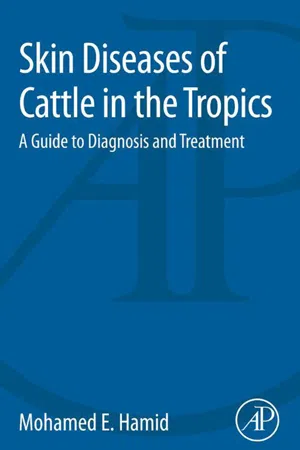
Skin Diseases of Cattle in the Tropics
A Guide to Diagnosis and Treatment
- 98 pages
- English
- ePUB (mobile friendly)
- Available on iOS & Android
About This Book
Skin Diseases of Cattle in the Tropics: A Guide to Diagnosis and Treatment is a clinical and practical guide to help animal scientists, field veterinarians, veterinary students, and technicians make appropriate and differential diagnoses. It features quizzes of clinical cases, along with multiple images of characteristic lesions and laboratory findings of major skin diseases (and diseases with skin manifestations) that are prevalent in tropical areas, notably the Sub-Saharan African countries.
This self-learning and easy-to-use instructional guide, a unique offering in the field of animal science and veterinary medicine, provides essential and foundational information about relevant skin conditions that are followed by illustrated flow charts of laboratory diagnoses and summaries of respective diseases.
This title makes the subject accessible for practicing veterinarians and animal scientists, and is particularly useful for those who have neither seen nor had the chance to see these diseases in the field or clinics. Such diseases are important not only in the tropics, but may be encountered in many countries in subtropical and temperate zones.
- Features more than 100 images of lesions and laboratory findings of major skin diseases and diseases with skin manifestations that are prevalent in tropical areas
- Includes clinical-case quizzes for self-directed learning
- Covers laboratory diagnosis, clinical presentations, and the summary of all important facts about the disease, including their etiology
Frequently asked questions
Information
Clinical Quiz No. 1
Abstract
Keywords

Laboratory Diagnosis
Specimen
Laboratory Tests and Findings



Diagnosis: Dermatophilosis (Streptothricosis, Rain Scald)
Answer and Disease Summary
Etiology
Table of contents
- Cover image
- Title page
- Table of Contents
- Copyright
- Introduction
- Part 1: Clinical Presentations, Laboratory Diagnosis and Disease Summaries
- Appendix
- Further Reading
- Index